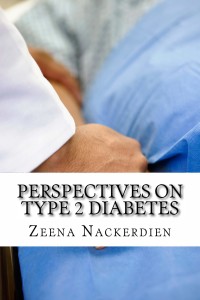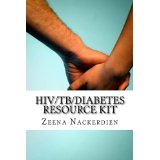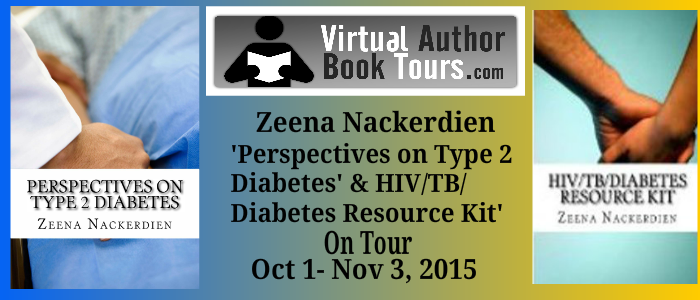Perspectives on Type 2 Diabetes by Zeena Nackerdien:
Publisher: Create Space (April 20, 2015)
CategoryNon-Fiction, Health, Type 2 Diabetes, HIV, TB, Patient Empowerment
Tour Dates: October/November, 2015
ISBN: 978-1511734837
ASIN: B00WGR90VK
Available in: Print & ebook, 41 Pages
The rising socioeconomic toll of diabetes, in particular the Type 2 form of the disease, is reverberating around the world. A disease that has sporadically plagued mankind for centuries seems to have increased in prevalence in tandem with rapid economic transitions, notably in countries with the highest number of diabetics such as China and the USA.
This resource guide is comprised of information about diabetes in those countries as well as in the Middle East, North Africa, and South Africa. In addition, the latest antidiabetic therapies and infectious comorbidities associated with the disease are discussed in separate chapters. Scattered throughout the guide are fictional scenarios about challenges diabetics and their doctors might face in individualizing recommended management algorithms.
Praise for Perspectives on Type 2 Diabetes by Zeena Nackerdien:
Type 2 diabetes, characterized by the body’s progressive inability to utilize insulin, is rapidly approaching a prevalence of one in ten (9.3% in 2014) in both the U.S. and China. This silent epidemic manifests itself initally as a rise in blood sugar.
Dr. Nackerdien found herself challenged by signs of the early stages of this condition, and has produced an excellent summary of early intervention goals and guidelines. This “translation” of technical information to an understandable guideline format is a must-have for real people who find themselves on the cusp of this debilitating condition.”- Curt, Amazon Reviewer
 HIV/TB/Diabetes Resource Kit by Zeena Nackerdien:
HIV/TB/Diabetes Resource Kit by Zeena Nackerdien:
Publisher: Create Space (April 23, 2015)
CategoryNon-Fiction, Health, Type 2 Diabetes, HIV, TB, Patient Empowerment
Tour Dates: October/November, 2015
ISBN: 978-1511864060
ASIN: B00WMNRDWG
Available in: ebook, 35 Pages
Who are the groups likely to be in the frontlines of either administering or receiving anti-HIV/AIDS-containing treatments for this disease and any associated comorbidities? The answer is frontline healthcare professionals, lay educators, and patients, especially in high-disease burden countries such as South Africa. While the reinvigorated national response to HIV/AIDS underscores the country’s commitment to the health crisis, the socioeconomic costs are likely to have a lasting impact on its citizens.
I have compiled a resource kit outlining some of the challenges faced in the treatment of patients with HIV, TB, and diabetes. In addition, the kit contains disease management and prevention tips suited for discussions with healthcare professionals, particularly in resource-poor settings.
Interview with Zeena Nackerdien:
What turned you from scientist to patient advocate?
Memories of home and a personal health scare definitely spurred my interest in patient advocacy. Growing up in South Africa, I was surrounded by people who had limited access to optimal health care or education. Apartheid was certainly a factor, but the overwhelming reasons remain poverty and a lack of education. Members of the community suffering from untreated tuberculosis or dying from prematurely from treatable chronic illnesses were common phenomena. During the eighties and the nineties, when integrating the country was the number one theme on the minds of most youths, the plight of sick people became just another price that had to be paid for living in tumultuous times. However, illness does not magically disappear, even when a country is blessed with leadership of heroic figures such as Nelson Mandela.
After completing my own studies in biochemistry and microbiology, I had a health scare which caused me to reflect more deeply on how I improve my own health and educate others. I was helped at the time by working with Martyn Hooper, head of The Pernicious Anaemia Society (a non-profit organization based in Wales).
Thanks to the digital era, we could communicate about challenges and opportunities he had encountered in spreading the word about an under-appreciated disease with roots that can be traced back to vitamin-B12-deficiency. I, in turn, learned to frame the specialized academic language that had stood me in good stead in terms of publishing peer-reviewed publications to suit patients or would-be patients. Together with research on how Americans struck a blow against HIV/AIDS, that experience was valuable in communicating information about three diseases that continue to affect sub-Saharan Africans ie, HIV/AIDS, TB, and Type 2 diabetes.
You have lived in both South Africa and the United States, how does patient advocacy differ from each part of the world.
The short answer is healthcare resources and money. The longer answer is as follows: Patient advocacy involves peers collaborating with appropriate healthcare stakeholders to empower patients with accurate information in order to make informed decisions about evidence-based treatment. The historical struggles and triumphs of patient advocates in the USA, notably in combatting HIV/AIDS, have served as a template for likeminded citizens of other countries, including South Africa (SA).
Because I have elaborated on some of the historical reasons for delayed HIV/AIDS treatment in SA in The Heroine Next Door and in an infographic, I will not repeat those details here. Suffice it to say that South Africa has made immense strides in enabling access to antiretroviral treatments and in launching several campaigns to increase disease awareness. My heroine, Leila, goes back to the country to facilitate collaborations among different parties that would lead such campaigns.
In addition to government involvement, outspoken leaders such as Treatment Action Campaign co-founder, Abdurrazack “Zackie” Achmat, Archbishop Desmond Tutu, and leading South African HIV/AIDS researchers have propelled the country back from the brink of disaster. American aid was indispensable in facilitating health advances in the country, but aid alone is not enough, as illustrated by a 2014 survey showing that a disproportionate number of young girls become newly infected with the virus.
To add to this complexity, successful treatment has become a double-edged sword, since patients now live longer and are likely to contract chronic ailments common in the West e.g., Type 2 diabetes. That places an additional burden on South African patient advocates to facilitate adherence to treatments for infectious and non-infectious diseases. It is enough to make one’s head spin. Readers who are intrigued after finishing The Heroine Next Door, should read the HIV/TB/Diabetes resource kit for examples of how people are addressing this question.
How did you make the leap from scientist, to patient advocate, and now, fiction and non-fiction author?
With difficulty. Writing technical jargon comes naturally to me. After decades of pouring over minutiae (ie, my version of non-fiction) that would make the average Joe’s toes curl, it was hard to find a relatable form of communication with non-experts. I still find myself lapsing into molecular pathways every so often, until a well-meaning friend prods me to the bottom line.
Being hospitalized in 2007, forced me to confront my own mortality and to cut through to the bottom line of how academic papers translate into actions that can benefit patients, who frequently do not have the luxury of waiting around for years and years until a hypothesis is proven or tossed aside. I am under no illusion that my first attempt at fiction falls in the easy-to-read genre. However, the fact that it deals with an educated Muslim woman going about her daily business, having friends, and collaborating with others to solve problems ie, boring stuff that rarely gets mentioned in the news, will hopefully be of interest to people. Love it or leave it, but we live in a complicated world and every book that enables us to understand one another, instead of getting into Twitter/real wars, is a step in the right direction.
What prompted you to write ‘Perspectives on Type 2 Diabetes’ and ‘HIV/TB/Diabetes Resource Kit’?
Like most people, I have a deep connection to food, especially sugar-laden concoctions destined to have my doctor hyper-ventilate after reading my blood results. Type 2 diabetes also runs in my family. After my brother died from complications due to the disease, I wrote a work of historical fiction, where my heroine helps people in her come country in framing a health plan to cope with HIV/TB and Type 2 diabetes. However, all the specifics that I could not include, for fear of having my prospective readers run for the hills, had to go somewhere. These two books were the result.
Are the treatments and the way patients are treated different in South Africa versus the United States? If so, how?
I have to issue the usual disclaimer that I am not a medical doctor and that anything I say is just my personal opinion and not representative of any organization’s views. Having said that, money and education make a huge difference in treatment received in either country.
History and differing literacy levels of patients aside, there is a lag time in getting the latest treatments or diagnostic devices to South Africa, but once this information arrives, it is typically concentrated in the cities and at top-tier academic institutions. Sound familiar? There is the added wrinkle that a large part of South Africa remains rural and the doctor-patient ratio is even bigger in that country than in the USA. Therefore, a large part of the burden of educating patients falls on nurses or health facilitators at mobile clinics.
Because South Africa has 11 official languages, these healthcare workers are often called upon to translate complicated treatments to their often-poorly-literate patients. This creates an added strain, probably only encountered by US healthcare workers dealing with rural or first-generation immigrant populations.
About Zeena Nackerdien:
Zeena Nackerdien is a dual US and South African citizen. She obtained a PhD degree in Biochemistry from the University of Stellenbosch in South Africa. Zeena has been a research chemist at the National Institute of Standards and Technology in Maryland and a senior research associate at The Rockefeller University in New York.
She is the author of several publications in scientific journals and two poetry collections, “Mist Over Peace” and “Scatterlings.” As a scientist turned patient advocate and writer, she is intensely interested in building relationships with people from different cultures through story-telling and education. Zeena currently lives in Brooklyn, New York.
Website: http://www.heroinenextdoor.com/
Facebook: https://www.facebook.com/zeenasbooks
Google+: https://plus.google.com/105525451604342478576/posts
LinkedIn: https://www.linkedin.com/pub/zeena-nackerdien/9/175/b6a
Pinterest: https://www.pinterest.com/zulu2/zeena-nackerdien/
Buy Perspectives on Type 2 Diabetes by Zeena Nackerdien:
Amazon
Barnes & Noble
Book Depository
Buy HIV/TB/Diabetes Resource Kit by Zeena Nackerdien:
Giveaway of Both Perspectives on Type 2 Diabetes & HIV/TB/Diabetes Resource Kit by Zeena Nackerdien:
This giveaway is for the ebook versions and is open worldwide. This giveaway ends on November 4, 2015. Entries are accepted via Rafflecopter only.
Follow the Perspectives on Type 2 Diabetes & HIV/TB/Diabetes Resource Kit by Zeena Nackerdien Tour:
Teddy Rose Book Reviews Oct 2 Interview & Giveaways
What U Talking Bout Willis? Oct 8 Guest Post & Excerpt
Avenue Books Oct 9 Guest Post & Excerpt
Teddy Rose Book Reviews Oct 16 Reviews
From Isi Oct 19 Reviews
Lady of Books Oct 20 Guest Post, Excerpt & Giveaways
Cassandra M’s Place Oct 22 Reviews & Giveaways
Celticlady’s Reviews Oct 26 Excerpt







